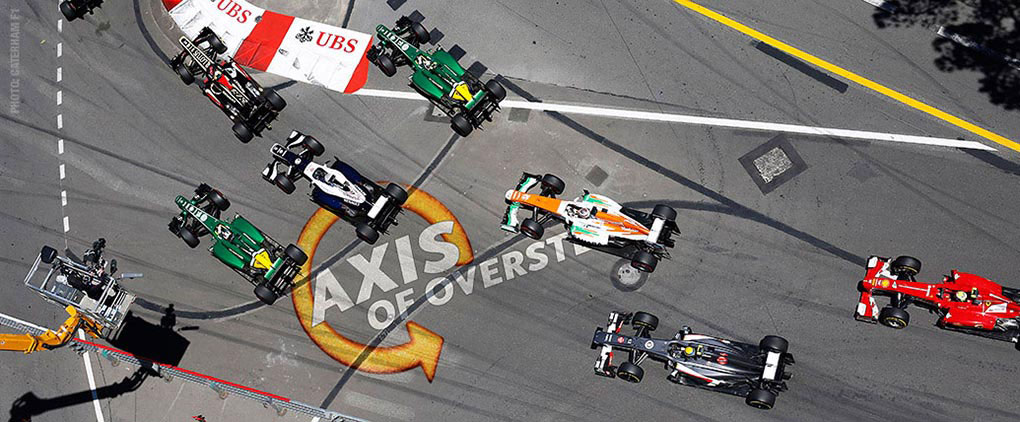December 18, 2013
And yet it moves: the RB9 yields another secret.
Finding the "secret" to the Red Bull RB9's seemingly unstoppable performance in the second part of the season has been quite a quest for specialists and fueled much discussion among fans.
Towards the later part of 2013 interest began to focus on the T-tray area, the flat section under the driver's seat which channels air to the the diffuser. There was much discussion about images seen via the FIA's thermal cameras, it was thought Red Bull had come up with a system which would allow movement once the oddly large amount of titanium fasteners were heated by friction. This theory was championed by BBC's Gary Anderson and it raised enough interest for the FIA to perform a special test, applying heat along with the required 200kg force to the part. It did not budge.
As it turns out Anderson was getting warmer. He wasn't the only one, many were curious as to why Red Bull mechanics were both very protective of and yet constantly adjusting something in that area. Giorgio Piola, along with Franco Nugnes at Omnicorse now shed some light on how Red Bull was able to run what is a completely forbidden moving aerodynamic device, perfectly legally!
First off, let's be clear that if a car passes FIA technical regulations as written it is by definition, legal. Making an end run on regulations and getting away with it is part of the essence of racing and engineering: the "Unfair Advantage", read it.
Newey, argues Piola, has always been a designer who has tended to miniaturize and willing to risk reliability to do so (case in point the size and placement of the KERS batteries which have caused many issues but were never changed). It was a surprise then when in Brazil, thanks perhaps to the team being a bit more relaxed, a photographer was able to snap a picture which showed the inside of the t-tray and keel assembly. It revealed a very large (for F1, 30cm) structure, bow shaped and hinged in the middle.
The structure, it is said, worked as a spring but only at values above the FIA's test. A force above 200 kg applied to one side of the lever would raise the front of the t-tray enough to allow Red Bull to run the car lower and with more rake without worrying about wearing though the compliance skid plate.
Combine this with the better exhaust blowing Renault engines were able to produce and the better way Newey channeled that energy to seal the raked rear and Vettel's ability to figure out how to take full advantage of the package and you understand how Red Bulls were able to regularly trounce their rivals.





This is some impressively sneaky engineering. The article at Omnicorse has a good technical explanation of the device but I'm still unclear as to how the force on the back end of the bow is being generated. Can anyone clear that up?
ReplyDeleteI have the same question! A driver only weighs, what, about 65kg?
ReplyDeleteWhere is the photo?
ReplyDelete"In occasione dell’ultimo Gp del Brasile, invece, il pezzo che è rimasto sempre “impacchettato” fra il T-Tray e lo skid block della Red Bull Racing è stato beccato da un fotografo che ha colto l’attimo in cui è calata l’attenzione dei meccanici di Milton Keynes."
"It was a surprise then when in Brazil, thanks perhaps to the team being a bit more relaxed, a photographer was able to snap a picture which showed the inside of the t-tray and keel assembly."
Just like Alonso with Renault, mass dampeners, and Michelin tires. Its all the car.
ReplyDeletePresumably downforce
ReplyDeleteas mentioned in the piece, not JUST the car but regular 30 second advantages don't happen from driving alone at that level.
ReplyDeleteThe only one I found is of the t-tray supports bending http://1.bp.blogspot.com/-nn6b3kQy9xo/UooCcATzlqI/AAAAAAAAIuQ/0t7JF5CbxqI/s1600/d13jpn1382+%2528Custom%2529.jpg
ReplyDeleteYeah that's the only thing that came to mind, especially when they said that the deflection only occurred when the car was in motion.
ReplyDeleteSo where´s the real picture?
ReplyDeleteI would think there has to be a link somewhere to the suspension. As downforce causes the car to sit lower in its suspension, somewhere, whether through direct pressure or indirect flexing of the chassis from the added load, that lever is pushed so that the tip of the tee-tray gets pulled upwards.
ReplyDeleteIt's all guesswork until the photos referred to the article gets posted. Even then, it'll still be guesswork. :D
Yup, I know they say this image could be related with camera effect... BUT this could explain a link between the suspension and this piece.
ReplyDeleteI had seen that gif but honestly, I don't know what to make of it, or what to look at! :)
ReplyDeleteIf look at the t-tray "support" it bends when it hits the ground from the rear and when the front hits it goes to the original position.
ReplyDeleteI'm calling support to the "rib / metal rod" that connects the T-Tray with the monocoque.
Actually is the same piece that is the image you put above, insert.
So where is the actual picture of this device? Well, I guess it doesn't exist... There is quite a lot of shots from Brazil including Sutton's and no visible sings of such thing.
ReplyDeleteMeh, with almost 30 years in F1 I'll take Giorgio Piola's word on it over just about anyone.
ReplyDeleteNorstl Manufacturer & bourgeois of copper nickel pipes. Shaanxi North Steel Co. manufacture & offer cupric nickel tube, coupon nickel pipe 90/10, coupon nickel fittings & cash fittings across the planet.
ReplyDelete